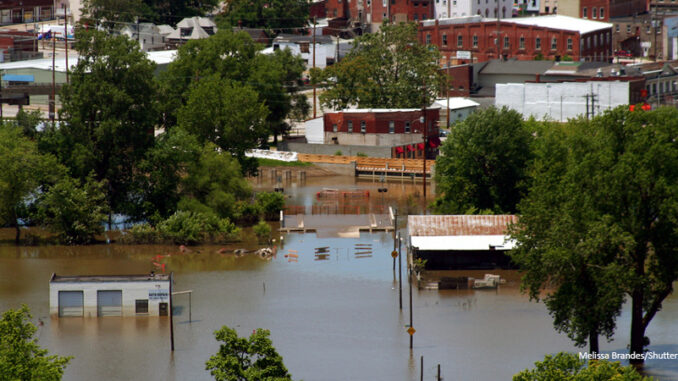
Hurricane Harvey: Recovery Efforts Begin
More than a week after Hurricane Harvey first made landfall in Texas, many areas are still heavily flooded. Some south Texas towns are suffering from high bacteria levels in their water, rendering it undrinkable. Hospitals and schools have had to close; in fact, ten to twelve thousand Houston students will have to move temporarily to new schools. Flooding also caused fires and explosions at a chemical plant outside of Houston. Roughly 27 trillion gallons of rain fell on Texas and Louisiana over a six-day period, and it may take ten to fifteen days for the water to recede completely.
The official death toll now has reached 50 people and is still rising. Meanwhile, over 72,000 people have been rescued and evacuated. The rest of the country is doing what it can to help with the relief effort. On Friday, the White House asked Congress for $7.85 billion in disaster relief funding. President Trump has promised to personally donate $1 million. Dozens of celebrities have stepped up as well, pledging thousands and even millions of dollars to the relief effort.
Sylvester Turner, the mayor of Houston, has asked for $75 million to $100 million in aid, just for the initial process of removing debris. He has also requested housing assistance and as many Federal Emergency Management Agency (FEMA) agents as possible to assist people in shelters and those who are still in their homes. According to the Texas governor, almost half a million people have registered for emergency assistance from FEMA in the wake of Harvey’s devastation.
But the worst may not be over yet. Hurricane Irma is currently moving through the Atlantic Ocean and could impact the southeastern United States as early as next week.
Dig Deeper While donating to the Red Cross is useful, Texas rescue authorities have urged people to donate to local organizations directly instead, such as to food banks, blood/plasma centers, and animal protection services. With the help of online resources, identify three such places and explain why they are in need of donations.
New Mathematical Discoveries from the Past?
What if the techniques and equations you’re learning in your trigonometry class are more than 3,700 years old? According to two Australian mathematicians, that may be true.

Here’s the story: in the early 1900s, a stone tablet about five inches wide and 3.5 inches tall was discovered in southern Iraq (or the area once known as Babylon). The tablet contained sixty numbers organized into fifteen rows and four columns. Based on the cuneiform style of writing used, scientists were able to estimate that the Babylonian tablet originated between 1822 and 1762 B.C.E. It became known as Plimpton 322 because it eventually was owned by George Arthur Plimpton, an American publisher. The collection was later donated to Columbia University.
Then, in the 1940s, mathematics historians examined the columns of numbers on the tablet and realized that they were Pythagorean triples, or numbers that satisfy the equation a2 + b2 = c2 (in other words, the square of a the longest side of a triangle, or its hypotenuse, is the sum of the squares of the other two sides).
Now, two Australian mathematicians believe that the tablet was indeed used to calculate solutions to trigonometry problems (math problems involving triangles). This is an important finding, because the discovery of trigonometry has always been attributed to the Greeks. With this discovery, it seems that the Babylonians actually were solving these equations at least 1500 years before the Greeks did. Even more remarkable, the ratios appearing on the Babylonian tablet are more accurate than calculations that mathematicians were doing 3,000 years later.
What Do You Think? Why do you think scientists and mathematicians are so interested in learning about what is written on this ancient tablet? What can their discoveries teach us about Babylonian society?
Sierra Leone Jogging Ban
Imagine a law limiting your right to go for a run in your neighborhood. That’s what’s happening in Sierra Leone, where the national police force has issued a statement prohibiting group jogging.
Exercising in groups has been a popular pastime in Sierra Leone for decades. Now, however, authorities are accusing the joggers of being loud and disorderly, disrupting traffic, and even robbing people as they pass by. According to the police, putting an end to group jogging is a matter of public safety.
But many people in Sierra Leone disagree. They argue that most group jogging happens on the weekends, when shops are closed and the streets are nearly empty anyway. It is possible that the real motivation is that the ruling party is nervous about the upcoming presidential election. When the All People’s Congress took power a decade ago, they did it in part by paying young people to jog in packs on the weekends shouting anti-government slogans. People suspect that they are now worried that the same tactics will be used against them.
Citizens of Sierra Leone don’t enjoy the same freedom to assemble that is true in the United States. In order to assemble as a group, they are required to have clearance from police. For now, group jogging is still permitted along beaches and in designated recreational areas, like athletic tracks. Some exercise groups are sticking to these areas, while others are trying to register their groups as social clubs, which would give them more freedom but is an expensive and time-consuming process.
Dig Deeper To better understand the story, use internet resources to briefly research the All People’s Congress, which took power ten years ago. What form of government exists in Sierra Leone today? Who is its current leader?
U.S. Closes Russian Diplomatic Consulates
At the end of July, Russian President Vladimir Putin ordered the United States to cut its diplomatic staff in Russia by 755 people. A month later, the U.S. has finally responded: by closing the Russian diplomatic consulate in San Francisco and two annexes in New York and Washington.
In a phone call last Thursday morning, U.S. Secretary of State Rex Tillerson communicated the message about the closings to Russian’s foreign minister, Sergey Lavrov. Although the closings are the latest step in ever-rising tensions between the United States and Russia, the administration is making it clear that the announcement was made, and received, calmly.
No Russian diplomats are being expelled from the U.S., and the Russian Embassy in Washington will not lose any staff. And though it is still unclear how many Russian diplomatic staff members will lose their jobs, the administration says it will be nowhere close to 755. However, the San Francisco consulate is Russia’s oldest and most established one in the U.S., and is especially valuable to Russia due to its proximity to the Silicon Valley. After the closings, the U.S. and Russia will each have three diplomatic consulates in the other country.
In September, Tillerson and Lavrov will meet during the United Nations General Assembly session. The White House hopes that this meeting will help alleviate tensions between the two nations. Putin is up for re-election next year, and his anti-U.S. stance is popular with many of his supporters.
